Polaris, Alpha Ursae Minoris (α UMi), is a yellow supergiant located approximately 446 light-years away in the constellation Ursa Minor. It is the current North Star, the closest visible star to the north celestial pole. It marks the end of the handle of the Little Dipper asterism.
The supergiant star has an apparent magnitude that varies between 1.86 and 2.13. It is classified as a classical Population I Cepheid variable and is the nearest star of this kind to Earth.
Polaris is the brightest star in Ursa Minor and, on average, the 48th brightest star in the night sky. While it is not a first magnitude star, as a yellow supergiant, the star is immense and highly luminous. It does not appear brighter because it lies at such a great distance.
In 2024, astronomers used the CHARA array to measure the changes in the size of Polaris, map the orbit with its close companion, and capture images of the supergiant’s surface. Even though it is one of the most studied stars in the sky, Polaris has some unusual properties that make its exact size and distance difficult to determine.
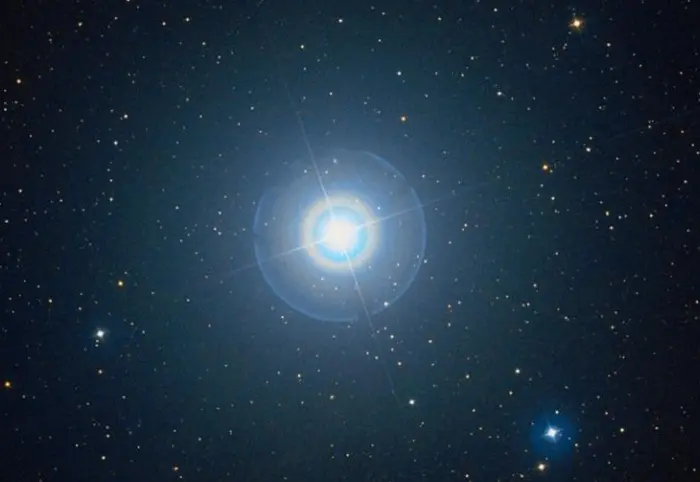
Polaris (Alpha Ursae Minoris) – the North Star, image: Wikisky (DSS2)
Star system
Alpha Ursae Minoris is a triple star system composed of the yellow supergiant Polaris (Alpha Ursae Minoris Aa) and two fainter companion stars. Both companions are F-type main sequence stars, designated Alpha Ursae Minoris Ab and B.
Alpha Ursae Minoris Aa and Ab orbit each other with a period of 29.416 years at a distance of at least 2.90 astronomical units (AU). They are separated by only 0.12955 arcseconds in the sky.
The component Alpha Ursae Minoris B orbits the pair at an angular distance of 18.217 arcseconds, corresponding to a physical distance of 2,400 AU. The star can be resolved in a small telescope.
Polaris (α Ursae Minoris Aa)
Polaris, Alpha UMi Aa, is a yellow supergiant of the spectral type F7Ib. It has a mass 5.13 times that of the Sun and has expanded to a size of 37.5 – 46.27 solar radii as it evolved away from the main sequence. The supergiant was the first variable star of its type to have its mass calculated from its orbit.
With a surface temperature of 6,015 K, Polaris is 1,260 times more luminous than the Sun. It has a metal content 112% that of the Sun.
The star has an estimated age between 45 and 67 million years. It spins at 14 km/s, taking 119 days to complete a rotation.
In 2024, a team of astronomers led by Nancy Evans at the Harvard–Smithsonian Center for Astrophysics observed Polaris with the CHARA array (Center for High Angular Resolution Astronomy) to map the orbit of the close companion (Ab) and measure the changes in the size of Polaris as it pulsated. The CHARA array is an optical interferometer that consists of a set of six 1-metre telescopes located on Mount Wilson in California. The telescopes combined act like a single large astronomical interferometer.
The team determined a mass of 5.13 ± 0.28 solar masses from the orbital motion and a radius 46.27 times that of the Sun. The study was published in The Astrophysical Journal on August 20, 2024.
The astronomers also used the MIRC-X (Michigan InfraRed Combiner-eXeter) camera, developed by scientists at the University of Michigan and Exeter University, to image the surface of Polaris. The images revealed new surface details, including large dark and bright spots that changed over time. The starspots, combined with rotation, may be linked to a photometric variation with a period of 120 days.
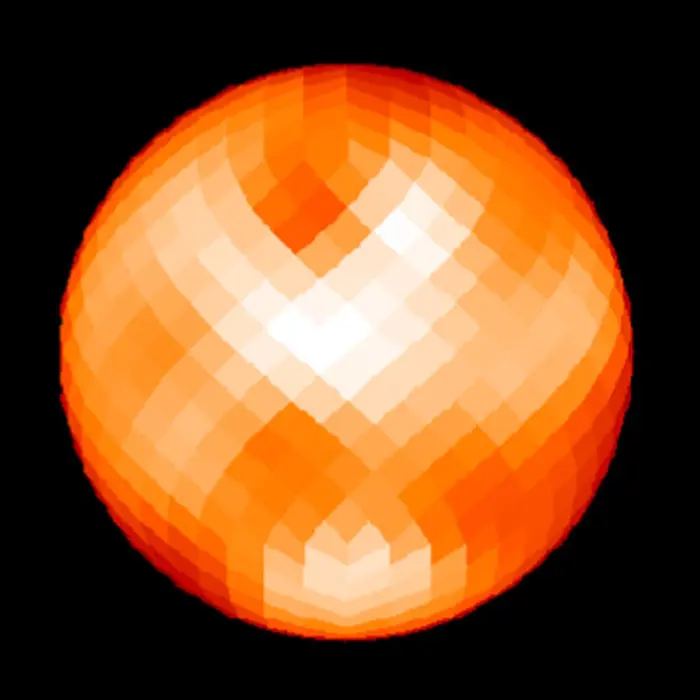
CHARA Array false-color image of Polaris from April 2021 that reveals large bright and dark spots on the surface. Polaris appears about 600,000 times smaller than the full Moon in the sky. Image credit: MIRC-X – Center for High Angular Resolution Astronomy (CHARA) (CC BY 4.0)
Polaris Aa is classified as a low-amplitude Cepheid variable. As the nearest Cepheid to Earth, it has been a frequent object of study. Cepheids are important in astronomy because they are used as standard candles – objects with known luminosities – to measure distances to distant deep sky objects.
With classical Cepheids, astronomers use the relation between their periods and luminosity to determine distances to objects both within the Milky Way and outside our galaxy. Cepheids were a critical factor that helped American astronomer Edwin Hubble prove that the Andromeda Galaxy (Messier 31) was not a nebula within the Milky Way, as previously believed, but an external galaxy.
Classical or Population I Cepheids are typically bright giants or low-luminosity supergiant stars with a mass of 4 to 20 solar masses, luminosities between 1,000 and 50,000 times that of the Sun, and radii a few tens to a few hundred solar radii. They have the spectral classification between F6 and K2.
Classical Cepheids are pulsating variable stars whose temperature, radius and spectral type change as they pulsate. Their brightness changes from a few tenths of a magnitude to 2 magnitudes. These stars have a well-defined period-luminosity relationship; the longer the pulsation period, the more luminous they are.
Other relatively bright classical Cepheids include Eta Aquilae in the constellation Aquila, l Carinae in Carina, Mekbuda (Zeta Geminorum) in Gemini, Beta Doradus in Dorado, and the class prototype Delta Cephei in Cepheus. Polaris is the brightest and closest Cepheid to Earth.
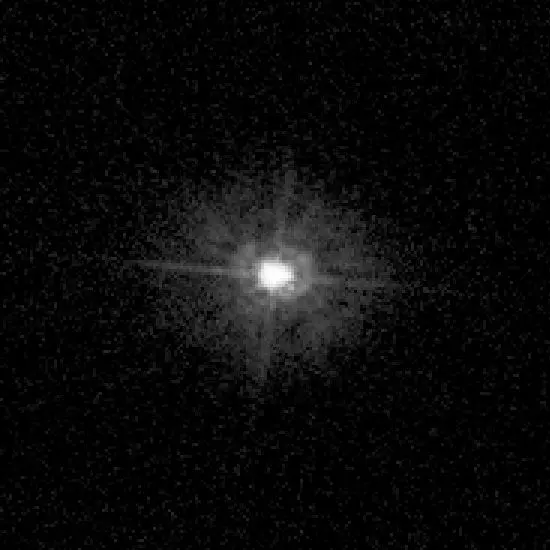
Polaris Aa and Polaris Ab resolved by the Hubble Space Telescope in 2006. Image credit: NASA/ESA and Hubble (PD)
α Ursae Minoris Ab
The close companion, Alpha UMi Ab, is an F6-type main sequence star with a mass of 1.316 solar masses and a radius of 1.04 solar radii. The star is three times more luminous than the Sun. It is believed to be at least 500 million years old.
The existence of Alpha Ursae Minoris Ab was suspected as early as 1899, when American astronomer William Wallace Campbell reported the variable radial velocity of the primary component, indicating the presence of a companion.
In 1929, a study of the star’s spectrum revealed that Polaris was in fact two stars in a tight orbit, confirming the earlier theory that the main component was a binary star.
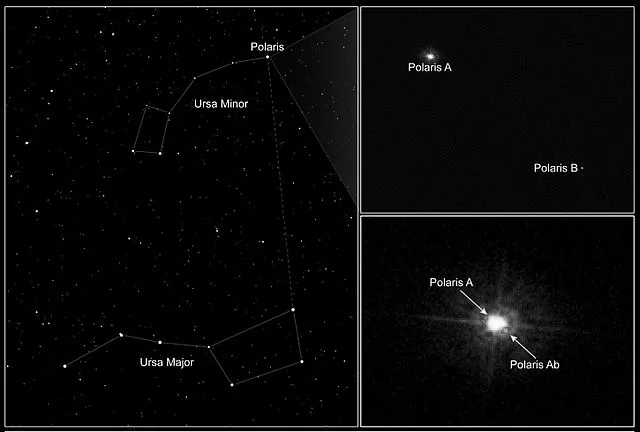
Polaris (Alpha Ursae Minoris) as seen by the Hubble Space Telescope, image: NASA/ESA/HST (PD)
α Ursae Minoris B
Alpha UMi B is a main sequence star of the spectral type F3V. Unlike Polaris, it is not visible to the unaided eye. It has an apparent magnitude of 8.7.
Alpha UMi B is the oldest of the three components in the Polaris system, with an estimated age of 1.5 billion years. The star has a mass of 1.39 solar masses and a radius of 1.38 solar radii. With an effective temperature of 6,900 K, it shines with 3.9 solar luminosities. It is a fast spinner, with a projected rotational velocity of 110 km/s.
Polaris B was discovered by the German-born British astronomer William Herschel in August 1779 using a reflector telescope. The star can be observed even in modest-sized telescopes.
At one time, astronomers believed there were two other, more distant stars in the system, designated Polaris C and Polaris D. However, these stars were later discovered to not be physically related to the three components of the Polaris system.
In January 2006, images taken by the Hubble Space Telescope showed all three members of the Polaris star system. It was the first time the close companion, Polaris Ab, was seen directly.
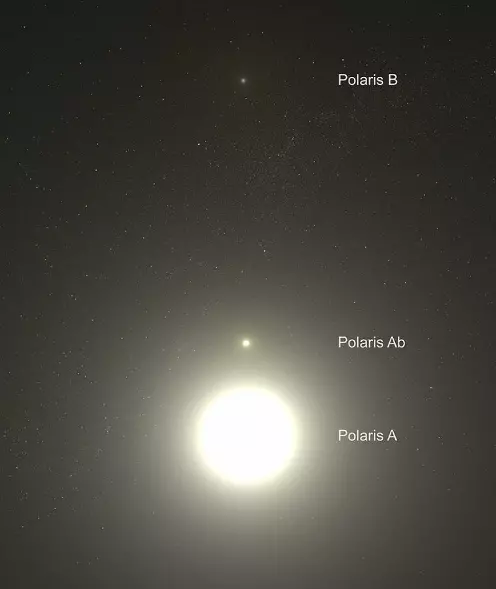
Polaris star system imaged by the Hubble Space Telescope, credit: NASA/ESA/HST, G. Bacon (STScI) (PD)
Distance
The currently accepted distance of 446 light-years is based on the data obtained with the European Space Agency’s Gaia satellite.
Polaris’ distance has long been uncertain. The revised parallax obtained from the Hipparcos satellite data gave a value of 433 light years, but older estimates placed the supergiant closer to us. Studies based on spectral analysis indicated that the star may be 323 light years (99 parsecs) away.
The accuracy of the data collected by the Hipparcos satellite in 1989 and 1993 has been questioned in the cases of Cepheid variables in binary star systems. Even though the data has been re-examined and confirmed, there is still no single value that has been widely accepted.
A more recent astrometry mission launched with the Gaia space observatory, the successor to Hipparcos, in 2013, was originally limited to stars dimmer than magnitude 5.7. However, it proved to work even with magnitude 3 stars.
The Gaia Data Release 2 (Gaia DR2) did not provide a parallax for Alpha UMi A, but astronomers were able to derive a distance of 136.6 ± 0.5 parsecs (443.57 light years) for Alpha UMi B. The estimate placed the star further away, but was significantly more accurate.
In 2023, astronomers determined a distance of 446 ± 1 light-years (136.90 ± 0.34 parsecs) for Polaris B based on the data in the Gaia Data Release 3 (Gaia DR3).
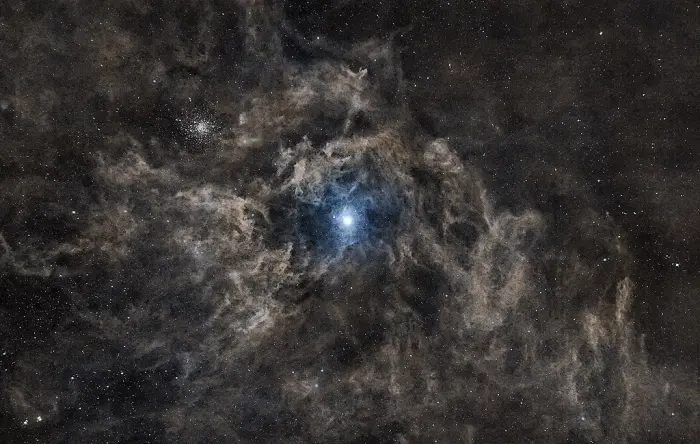
The integrated flux nebula around Polaris. The ancient open cluster NGC 188 (Caldwell 1, the Polarissima Cluster) in the constellation Cepheus is visible to the upper left. Image credit: Kush Chandaria, 2021 (CC BY-SA 4.0)
Brightness
Polaris is the 48th brightest star in the sky. It appears about as bright as Mirzam in the constellation Canis Major, Alphard in Hydra, Algieba in Leo, and Hamal in Aries. As a second magnitude star, Polaris is easily visible from light-polluted areas, but it is not exceptionally bright.
Astronomers had suspected the primary star in the Polaris system to be variable since 1852, but its variability was not confirmed until 1911, when Danish astronomer Ejnar Hertzsprung demonstrated it.
Hertzsprung went on to determine the distances to several such stars using parallax in 1913. Both his work and Edwin Hubble’s relied on American astronomer Henrietta Leavitt’s discovery of the period-luminosity relationship in pulsating variable stars in 1908. Leavitt was investigating variable stars in the Magellanic Clouds at the time and published her findings in 1912.
Polaris varies in brightness from magnitude 1.86 to 2.13, but the amplitude is not the same as it was at the time of discovery. Before 1963, it was more than 0.1 magnitude and slowly decreasing until 1966, when it had a dramatic decrease to less than 0.05 magnitude. The amplitude has varied unpredictably since, but stayed close to those values. A paper published in 2008 reported that it was increasing again, which is unprecedented in a star of this type.
Polaris Aa has a variation period of about four days, but the period has not stayed the same either. Astronomers noticed a gradual increase by roughly 4-5 seconds per year, with a break between 1963 and 1965. The star’s temperature varies only slightly as the star pulsates, but the variation itself is erratic, from 50 K to 170 K or more. Astronomers have speculated that the unpredictability may be due to the star’s orbit with Polaris Ab.
Research conducted in the last two decades suggests that Polaris is 4.6 times brighter today than it was when Ptolemy observed it (137 CE). A team of scientists began to monitor the star in 1999 and discovered that, after reaching a minimum, the amplitude of the star’s pulsations was increasing again. As they researched historical records, they discovered that the star was fainter the further back they went.
Cepheids have been very important for a very long time because their consistency allows astronomers to use them as standard candles. However, Polaris is not the only star of this type found to exhibit unexpected changes in brightness in the long term. Many other Cepheids show similar changes, which indicates that these stars are more complex than previously believed.
North Star
Polaris is the closest visible star to the north celestial pole. It does not mark the exact location of the pole, but it is very close to it. It lies in line with the Earth’s northern axis of rotation, almost directly above the North Pole and, for hypothetical observers at the pole, the star would be directly overhead.
With the rotational axis pointed almost directly at the star, Polaris does not rise or set for northern observers. Because it is so near the north celestial pole, it appears motionless in the sky and other stars appear to move in a circle around it. This makes Polaris highly useful in navigation and astrometry.
Polaris is currently moving closer to the north celestial pole. In 2018, it was 39.6 arcminutes (0.66 degrees) from the pole, equivalent to 1.4 times the width of the full Moon. It will make the closest approach on March 24, 2100 (at declination +89° 32’ 50.62’’), when it comes within about 27 arcminutes (0.45°) of the pole of rotation. It will then slowly begin to move away.
Because of its proximity to the north celestial pole, the star’s right ascension is always changing. The star’s apparent movement is the result of the Earth’s axial precession (the precession of the equinoxes), a slow change in the orientation of the Earth’s rotational axis.
The gradual precession of Earth’s axis occurs in a cycle of about 25,772 years and, as a consequence, the pole stars also change. Polaris is currently the closest visible star to the north celestial pole, but it will not stay the North Star forever, just as Sigma Octantis (Polaris Australis) will not be the marker of true south forever. More than a dozen different stars take on the role over the course of our planet’s precession cycle.
Polaris took over as the North Star from Kochab, Beta Ursae Minoris, around the year 500 CE. Kochab, the second brightest star in Ursa Minor and the brightest star in the bowl of the Little Dipper, held the title from 1500 BCE to 100 CE. Today, Kochab and Pherkad, Gamma Ursae Minoris, are known as the Guardians of the Pole. The two stars mark the outer edge of the Little Dipper’s pan and appear to rotate around Polaris and the pole.
In late antiquity, the northern celestial pole was at the same angular distance from Polaris as it was from Kochab. At this time, Polaris, the brighter of the two stars, started to become more important as a navigational star. Before Polaris became the nearest visible star to the pole, the entire Ursa Minor constellation was used for navigation. Polaris moved to within several degrees of the pole in the early Middle Ages, which is when it started being referred to as the “polar star.”
Polaris will be succeeded by Errai, Gamma Cephei. Around the year 3000, the pole will be halfway between Polaris and Errai and, around 4200, Errai will reach its closest point to the pole.
Of all the north stars, Polaris is the second closest to the pole. The only star that marks true north more accurately as the northern pole star is Thuban, Alpha Draconis. Thuban comes within 0.2° of the pole, while Polaris comes within 0.5°. However, Thuban is considerably dimmer at magnitude 3.65, which makes it slightly less useful as a marker. Thuban was the North Star from the 4th to the 2nd millennium BCE.
The brightest of the north stars, Vega, has an apparent magnitude of 0.026, but only comes within 5° of the pole.
Other than Polaris, Errai (Alrai), Vega, Thuban and Kochab, the stars that act as indicators of true north or near-north are Iota and Beta Cephei (Alfirk), which share the title of the North Star, Alderamin (Alpha Cephei), Deneb (Alpha Cygni), Fawaris (Delta Cygni), Iota Herculis, Tau Herculis, Edasich (Iota Draconis), and Kappa Draconis, which shares timing with Kochab.
Polaris will be the North Star again around the year 27800, but it will not be as close to the pole as it is now or when it had the title around 23600 BCE and came even closer to the pole than it is now.
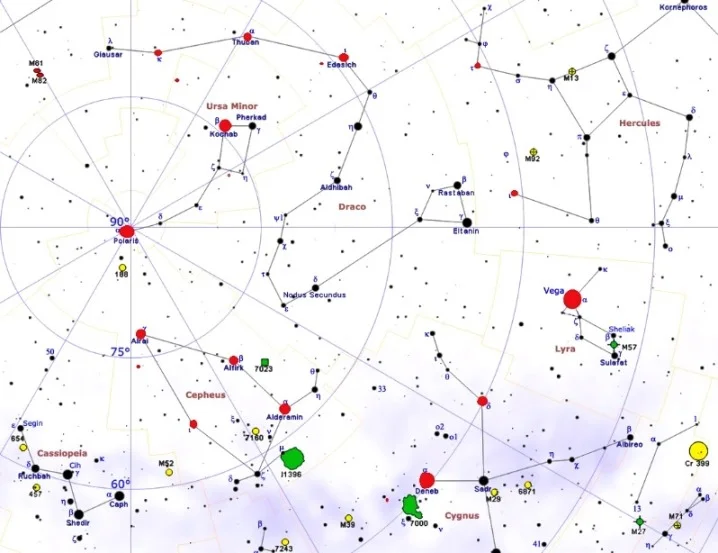
North Stars (marked red), image: Roberto Mura (CC BY-SA 3.0)
Facts
Polaris forms the Little Dipper asterism with Kochab (Beta Ursae Minoris), Pherkad (Gamma Ursae Minoris), Yildun (Delta Ursae Minoris), Zeta Ursae Minoris, Eta Ursae Minoris, and Epsilon Ursae Minoris. The Little Dipper is not small, but its middle four stars are relatively faint, making the asterism a challenging target from light-polluted areas.
Polaris, Yildun and Epsilon UMi form the handle of the Little Dipper and Kochab, Pherkad, Zeta and Eta UMi outline the bowl. Polaris, Kochab and Pherkad are visible even from urban areas, but the remaining four stars are fainter than magnitude 4.0 and they do not stand out in the sky, even in good conditions.
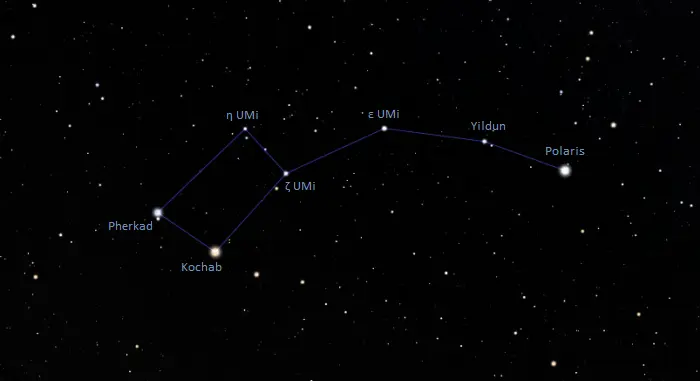
The stars of the Little Dipper, image: Stellarium
Polaris is also part of a telescopic asterism known as the Engagement Ring or Diamond Ring. The asterism is visible in a small telescope. It is also formed by a small semicircle of about 10 faint stars in the constellations Ursa Minor and Cepheus.
The Diamond Ring asterism is less than a degree across and can be used to find the exact location of the north celestial pole. The pole appears on the opposite side of the ring, at a separation that is a little less than the diameter of the ring.
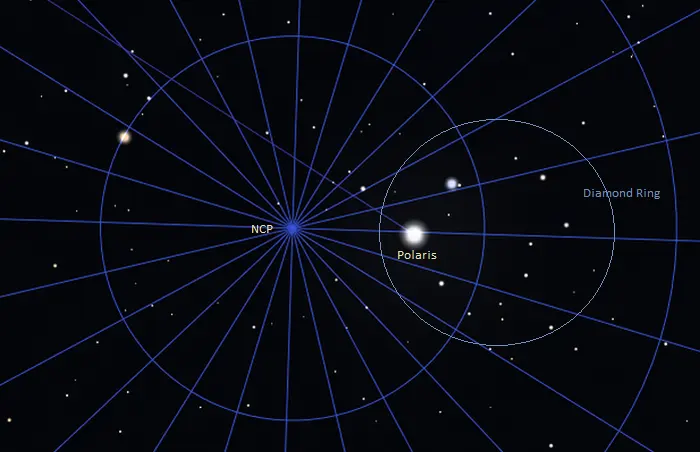
Polaris, the Diamond Ring and the north celestial pole, image: Stellarium
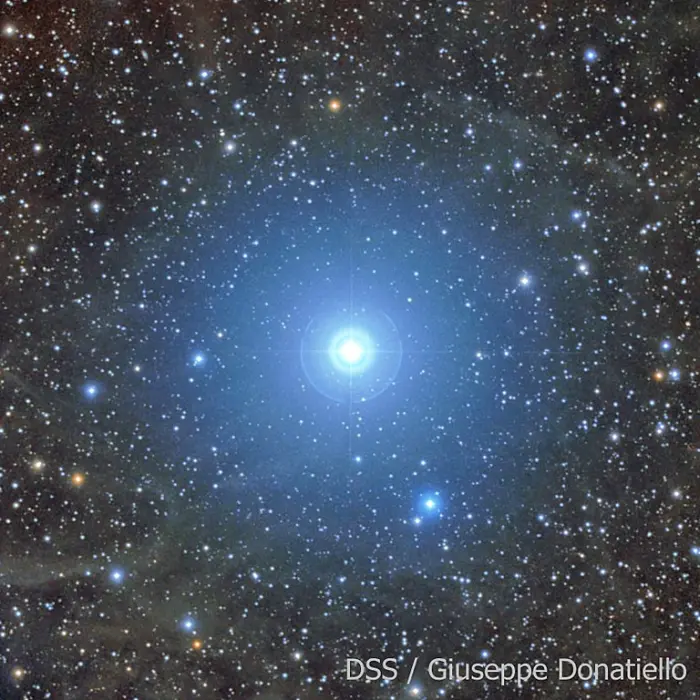
Polaris, image: DSS / Giuseppe Donatiello (CC0 1.0)
Name
The name Polaris is short for stella polaris, which is Latin for “polar star.” The name dates back to the Renaissance era, when Polaris came within a few degrees of the north celestial pole. The Dutch physician, geographer and mathematician Gemma Frisius mentioned the star as “stella illa quae polaris dicitur,” or “the star which is called ‘polar’” in 1547. Frisius determined the star’s distance from the pole to be 3° 7’.
The International Astronomical Union’s (IAU) Working Group on Star Names (WGSN) officially approved the name Polaris for Alpha Ursae Minoris Aa on June 30, 2016. While the name formally applies only to the primary component, it is also commonly used for the companion stars (Polaris Ab and Polaris B).
Polaris has been known by many other names throughout history. The star’s name in Old English was scip-steorra, or “ship-star,” and an even older name was lodestar, meaning “guiding star.” The Old Norse name leiðarstjarna and Middle High German leitsterne share the same linguistic root. In the late 13th century, the star became known as Stella Maris, or “the star of the sea.”
By the early modern period, the name Cynosura was also used for Polaris. It is the old name for the constellation Ursa Minor, derived from the Greek κυνόσουρα, meaning “the dog’s tail.” The constellation was associated with a dog, not a bear, in ancient times.
In Hindu Puranic literature, Polaris was known as Dhruva, which means “immovable” or “fixed.”
The old Arabic name for the star was Al-Judeyy. The name dates back to pre-Islamic astronomy, before Polaris was as close to the pole as it is today.
Medieval Islamic astronomers knew the star by several different names: Mismar (“needle” or “nail”), al-kutb al-shamaliyy (“the northern axle”), and al-kaukab al-shamaliyy (“the north star”).
In the Berber language of the Tuareg people in North Africa, Polaris is known as Tatrit tan Tamasna, or “star of the plains.” The name reflects the star’s prominent role in navigating the great deserts.
The Inuit name for Polaris is Niqirtsuituq. The star is depicted both on the flag of the Inuit territory of Nunavut, the northernmost territory of Canada, and on the flag of Alaska, the northernmost state of the United States.
In traditional Chinese astronomy, Polaris was known as the First Star of Curved Array. Curved Array (勾陳,Gōu Chén) was an asterism also formed by Yildun (Delta UMi), Epsilon Ursae Minoris, Zeta Ursae Minoris, 2 Ursae Minoris, and HD 217382 in the neighbouring constellation Cepheus. The asterism was part of the Purple Forbidden Enclosure, one of the Three Enclosures in Chinese astronomy.
Location
Polaris is the northernmost visible star in the sky. It marks the approximate location of the north celestial pole and always appears in the same place in the sky from any given location.
The proximity of Polaris to the north celestial pole in the sky means that its distance from the horizon matches the observer’s latitude. For observers at the North Pole, the star is directly overhead, and the further south the observer is, the closer the star is to the northern horizon. For example, observers in New York can see it 41 degrees above the horizon because the city is located at latitude 41° N.
The easiest way to find Polaris is to extend a line from Merak (Beta Ursae Majoris) through Dubhe (Alpha Ursae Majoris), the outer stars of the Big Dipper’s bowl. Merak and Dubhe are known as the Pointer Stars because they point the way to the North Star and the north celestial pole. The distance from Dubhe to Polaris is about five times the distance from Merak to Dubhe. Dubhe, the second brightest star in Ursa Major, is slightly brighter than Polaris. It shines at magnitude 1.87 from a distance of 123 light-years.
Polaris is the brightest star near the imaginary line. It appears isolated in this region of the sky because there are no exceptionally bright stars nearby. Kochab, one of the Guardians of the Pole, is the only other second magnitude star in the area. Kochab and the fainter Pherkad appear parallel to Mizar and Alioth in the Big Dipper’s handle.
Polaris appears in the region between the Big Dipper and Cassiopeia’s W. It can be found by extending a line from Mizar, the middle star of the Big Dipper’s handle, to Segin, the leftmost star of Cassiopeia’s W.
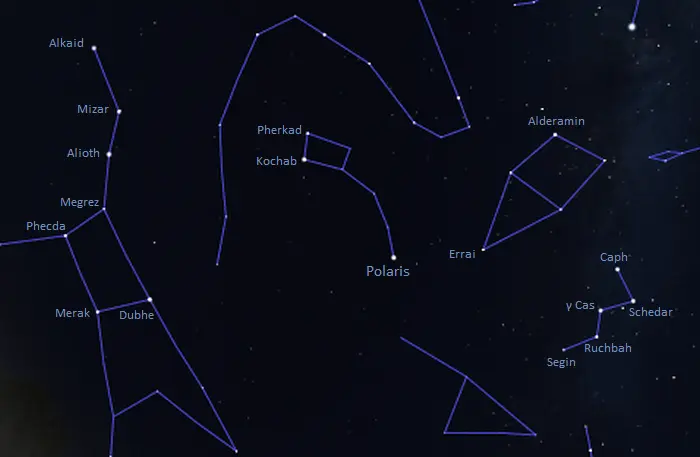
The location of Polaris (the North Star), image: Stellarium
Constellation
Polaris is the luminary of Ursa Minor, the northernmost constellation in the sky. The supergiant star marks the tip of the Little Bear’s tail.
Stretching across 256 square degrees of the northern sky, Ursa Minor is the 56th largest of the 88 constellations. With only three stars brighter than magnitude 3.0, it is one of the less conspicuous northern constellations.
Like its neighbours Cepheus and Draco, the Little Bear constellation is circumpolar to northern observers. It can be seen year-round from most locations in the northern hemisphere. From the southern hemisphere, the constellation is only partly visible from locations close to the equator.
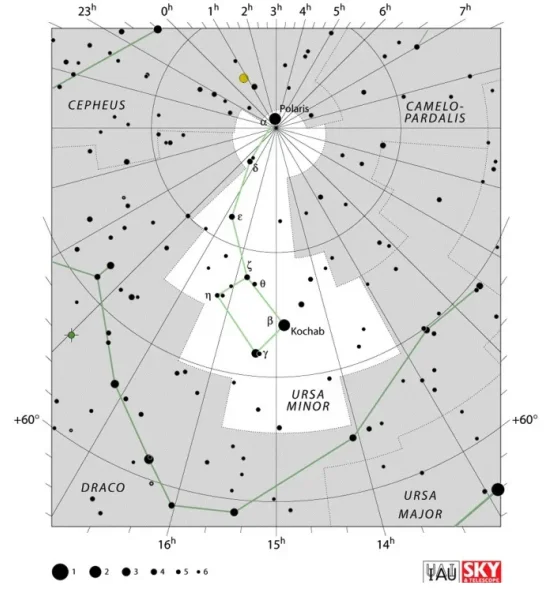
Ursa Minor constellation map by IAU and Sky&Telescope magazine (Roger Sinnott & Rick Fienberg) (CC BY 3.0)
Ursa Minor is one of the 48 Greek constellations, listed by the Greco-Roman astronomer Claudius Ptolemy of Alexandria in his Almagest in the 2nd century CE. The constellation was introduced by the Greek philosopher Thales of Miletus in the 6th century BCE. Thales found the stars of Ursa Minor useful in navigation.
Notable stars in Ursa Minor include the A-type giant or bright giant Pherkad (Gamma Ursae Minoris), the orange giants Kochab (Beta Ursae Minoris) and Theta Ursae Minoris, the variable carbon star Z Ursae Minoris, the variable red giants Lambda Ursae Minoris, RR Ursae Minoris and R Ursae Minoris, and the spectroscopic binary system Epsilon Ursae Minoris.
The constellation hosts two interesting stellar remnants, H1504+65, the hottest white dwarf discovered to date (with a surface temperature of 200,000 K) and Calvera (1RXS J141256.0+792204), one of the closest neutron stars to the Sun, nicknamed after the villain in the film The Magnificent Seven (1960).
Ursa Minor does not contain any particularly bright deep sky objects. It hosts the supergiant elliptical radio galaxy NGC 6251, the barred spiral galaxy NGC 6217, Polarissima Borealis (NGC 3172), the nearest New General Catalogue object to the north celestial pole, and the Milky Way satellite PGC 54074, also known as the Ursa Minor Dwarf.
The best time of the year to see the stars and deep sky objects in Ursa Minor is during the month of June, when the constellation appears higher above the horizon in the early evening. The entire constellation is visible from locations north of the latitude -10°.
The 10 brightest stars in Ursa Minor are Polaris (Alpha UMi, mag. 1.86 – 2.13), Kochab (Beta UMi, mag. 2.08), Pherkad (Gamma UMi, mag. 3.05), Epsilon Ursae Minoris (mag. 4.19), 5 Ursae Minoris (mag. 4.253), Zeta Ursae Minoris (mag. 4.32), Yildun (Delta UMi, mag. 4.36), RR Ursae Minoris (mag. 4.44 – 4.85), 4 Ursae Minoris (mag. 4.80), and Eta Ursae Minoris (mag. 4.95).
Polaris – Alpha Ursae Minoris
| Spectral class | F7Ib + F6 + F3V |
| Apparent magnitude | 1.98 (1.86 – 2.13), 8.7 |
| Absolute magnitude | -3.6, 3.6, 3.1 |
| Distance | 446 ± 1 light-years (136.90 ± 0.34 parsecs); 323–433 ly (99–133 pc) |
| Constellation | Ursa Minor |
| Names and designations | Polaris, Alpha Ursae Minoris, Alpha UMi, α Ursae Minoris, α UMi, North Star, Cynosura, Navigatoria, Star of Arcady, Phoenice, Mismar, Yilduz, Alruccabah, ADS 1477, CCDM J02319+8915 |
Alpha Ursae Minoris A
| Spectral class | F7Ib + F6 |
| Variable type | Classical Cepheid |
| U-B colour index | 0.38 |
| B-V colour index | 0.60 |
| Apparent magnitude | 1.98 (1.86 – 2.13) |
| Parallax | 7.54 ± 0.11 mas |
| Radial velocity | -16.42 ± 0.03 km/s |
| Proper motion | RA: 44.48 ± 0.11 mas/yr |
| Dec.: -11.85 ± 0.13 mas/yr | |
| Right ascension | 02h 31m 49.09456s |
| Declination | +89° 15′ 50.7923″ |
| Names and designations | Alpha Ursae Minoris A, 1 Ursae Minoris, 1 UMi, HR 424, HIP 11767, HD 8890, SAO 308, GC 2243, GCRV 1037, BD +88° 8, AG+89 4, FK5 907, GSC 04628-00237, JP11 498, N30 381, PLX 299.00, PMC 90-93 640, PPM 431, ROT 3491, TD1 835, TIC 303256075, WEB 2438, AAVSO 0122+88, UBV 21589, UBV M 8201, IRAS 01490+8901, 2MASS J02314822+8915503, TYC 4628-237-1, Gaia DR2 576402619921505664, ADS 1477 A, CCDM J02319+8915A, IDS 01226+8846 A, WDS J02318+8916A, WDS J02318+8916Aa,Ab |
Alpha Ursae Minoris Aa
| Spectral class | F7Ib |
| Variable type | Classical Cepheid |
| Apparent magnitude | 1.98 (1.86 – 2.13) |
| Absolute magnitude | -3.6 |
| Mass | 5.13 ± 0.28 M☉ |
| Luminosity | 1,260 L☉ |
| Radius | 37.5 – 46.27 R☉ |
| Temperature | 6,015 K |
| Metallicity | 112% solar |
| Age | 45 – 67 million years |
| Rotational velocity | 14 km/s |
| Rotation | 119 days |
| Surface gravity | 2.2 cgs |
| Names and designations | Polaris, Alpha Ursae Minoris Aa, Alpha UMi Aa, α Ursae Minoris Aa, α UMi Aa |
Alpha Ursae Minoris Ab
| Spectral class | F6 |
| Absolute magnitude | 3.6 |
| Mass | 1.316 M☉ |
| Luminosity | 3 L☉ |
| Radius | 1.04 R☉ |
| Age | >500 million years |
| Names and designations | Alpha Ursae Minoris Ab, Alpha UMi Ab, α Ursae Minoris Ab, α UMi Ab |
Alpha Ursae Minoris B
| Spectral class | F3 V |
| Variable type | Suspected |
| U-B colour index | 0.01 |
| B-V colour index | 0.42 |
| Apparent magnitude | 8.7 |
| Absolute magnitude | 3.1 |
| Parallax | 7.2869 ± 0.0178 mas |
| Radial velocity | -22.25 ± 8.11 km/s |
| Proper motion | RA: 41.961 ± 0.024 mas/yr |
| Dec.: -13.562 ± 0.021 mas/yr | |
| Mass | 1.39 M☉ |
| Luminosity | 3.9 L☉ |
| Radius | 138 R☉ |
| Temperature | 6,900 K |
| Age | 1.5 billion years |
| Rotational velocity | 110 km/s |
| Surface gravity | 4.3 cgs |
| Right ascension | 02h 30m 36.0860332537s |
| Declination | +89° 15′ 39.203146465″ |
| Names and designations | Polaris B, Alpha Ursae Minoris B, Alpha UMi B, α UMi B, 1 Ursae Minoris B, 1 UMi B, BD+88 7, GC 2226, GCRV 1031, SAO 305, GCRV 1031, GSC2.3 NA9S000158, NSV 631, ROT 3538, CSV 100114, UBV 1539, UBV M 4924, WEB 2427, AN 18.1903, Gaia DR2 576402619921510144, Gaia DR3 576402619921510144, STF 93B, ADS 1477 B, CCDM J02319+8915B, IDS 01226+8846 B, WDS J02318+8916B |